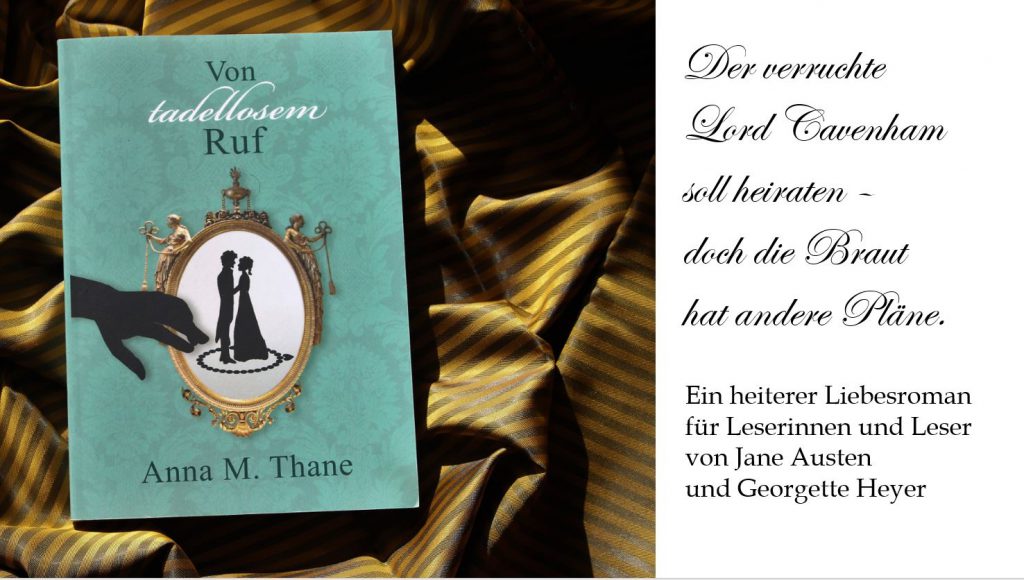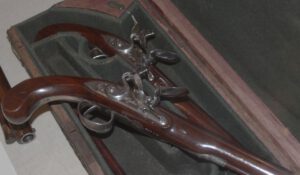 In Europe, duels were common from the Renaissance on among aristocrats and military men. While duels were usually fought with swords in the first part of the 18th century, pistols became popular in Britain from around the 1770ies, superseding swords as a weapon. Duelling was illegal, and killing a man in duel was considered murder. Nevertheless, duelling was commonly associated with notions of chivalry and a code of honour.
In Europe, duels were common from the Renaissance on among aristocrats and military men. While duels were usually fought with swords in the first part of the 18th century, pistols became popular in Britain from around the 1770ies, superseding swords as a weapon. Duelling was illegal, and killing a man in duel was considered murder. Nevertheless, duelling was commonly associated with notions of chivalry and a code of honour.
A code of honour defined rules for issuing a challenge as well as rules of engagement on the duelling ground. It regulated the conduct of seconds, and also specified which conduct would be considered dishonourable. Which rules guided duellist in the late 18th century and early 19th century?
The Strange Case of the Irish Code Duello of 1777
Allegedly, among the most important set of rules for duelling was the Irish Code Duello. Seemingly, it was a set of rules adopted at the Clonmel Summer Assizes in 1777, and it is so far believed to be have been indispensable knowledge for gentlemen of that time.
The Irish Code Duello is much-quoted in specialist books from the late 19th century until today. It also made its way into contemporary law dictionaries in the US and scholarly publications about general legal topics. Some sources also state that U.S. citizens based their duelling codes on the Irish Code Duello.
Strangely, the Irish Code Duello as a document is elusive, as everybody finds out who the tries to get a hold of it in online databases. Dianne L. Durante, an independent researcher, and freelance writer with a PhD in Classical Philology, conducted research on the Irish Code Duello. She also was the first person to point out that the first source of the Irish Code Duello is a book published in 1827, titled “Personal Sketches of His Own Times by Sir Jonah Barrington”. It’s a book in two volumes, the second one contains the Irish Code Duello.
Dianne L. Durante concludes that the Irish Code Duello is a tongue-in-cheek creation by Sir Jonah Barrington from 1827. I recommend reading her notable article about her discovery and the related research at her website: https://diannedurantewriter.com/archives/1646
You are welcome to read the rules of the Irish Code Duello as written down by Sir Jonah Barrington online here: https://books.google.com.mm/books?id=p2g9AAAAIAAJ&printsec=frontcover#v=onepage&q&f=false Volume 2, (p. 13 – p .22)
Books on Duelling Codes in the late 18th century and early 19th century
Dianne L. Durante’s research intrigued me. I tracked down copies of books on duelling from the late 18th century and the early 19th century. Then, I checked if their authors referred to the Irish Code Duello or any code of honour of duelling at all.
These are the books I studied:
- “The principles of duelling; with rules to be observed in every particular respecting it”, by Samuel Stanton (Lieut. 37th Regiment), published in 1790
- “A full inquiry Into the subject of suicide: to which are added (as being closely connected with the subject) two treatises on duelling and gaming in two volumes”, by Charles Moore, published in 1790
- “General rules and instructions for all seconds in duels, by a late captain in the army”, published in 1793
The book focuses on practical aspects providing the best chances to surviving a duel. The author states that no rules for duelling existed in writing so far, so that it is up to him to note them down. - “The Young Man of Honour’s Vade-mecum: Being a Salutory Treatise on Duelling, Together with the Annals of Chivalry, the Ordeal Trial, and Judicial Combat, from the Earliest Times”, by Abraham Bosquett, published in 1817
The book provides practical advice on loading a pistol, taking position when fighting a duel, and selecting a second. It also discusses the conduct and the duties of the second, and suggests methods to suppress duelling. - “Some Short and Useful Reflections Upon Duelling: Which Should be in the Hands of Every Person who is Liable to Receive a Challenge, Or an Offence” by Hamilton Joseph, published in 1823
The book does not contain a code for duelling, but quotes rules for principles and seconds written down by a late captain in the in 1793 (see above). Besides, it reflects on the history of duelling and duelling incidents. - “The only approved guide through all the stages of a quarrel: containing the royal code of honor; reflections upon duelling; and the outline of a court for the adjustment of disputes” by Hamilton, Joseph, published in 1829
This book is the first to describe a so called Royal Code of Honour with 60 rules. It also refers to the Irish Code Duello from 1777, naming the “Personal Sketches of his Own Times” by Sir Jonah Barrington as a souce. In moderately expressed doubt with reagrds to the authenticity of the Irish Code Duello, the author generally considered Sir Jonah as an apocryphal authority. - “Code of honour” by John Lyde Wilson, published in 1838. The book offers a full code of honour and rules for conduct at a duel. Please note that only the second edition published in 1858 had the Irish Code Duello added as an appendix. The author stated that he has never seen the Irish Code Duello, but that it was brought to his attention while his book was already in printing.The edition of 1858 is online here.
No significant books about duelling seemed to have been published around the early beginnings of the pistol duel from 1770 until 1790. None of the books prior to 1827 mentions or refers to the Irish Code Duello. This is significant, as they deal with either campaigning against duelling or advocating it. It would be highly unlikely that both opponents and proponents missed the change to quote these rules had they existed. They certainly would have used them for their goals. The anonymous author of a book about duelling published in 1793 even states that “no rules for duelling exists in writing so far”, and he felt himself compelled to “laying down Rules and Instructions for the Ignorant”.
From my research of 18th century literature on duelling, I can confirm Dianne L. Durante’s statement that the source of the Irish Code of Duelling is the version given by Sir Jonah in his entertaining but historically dubious memoires.
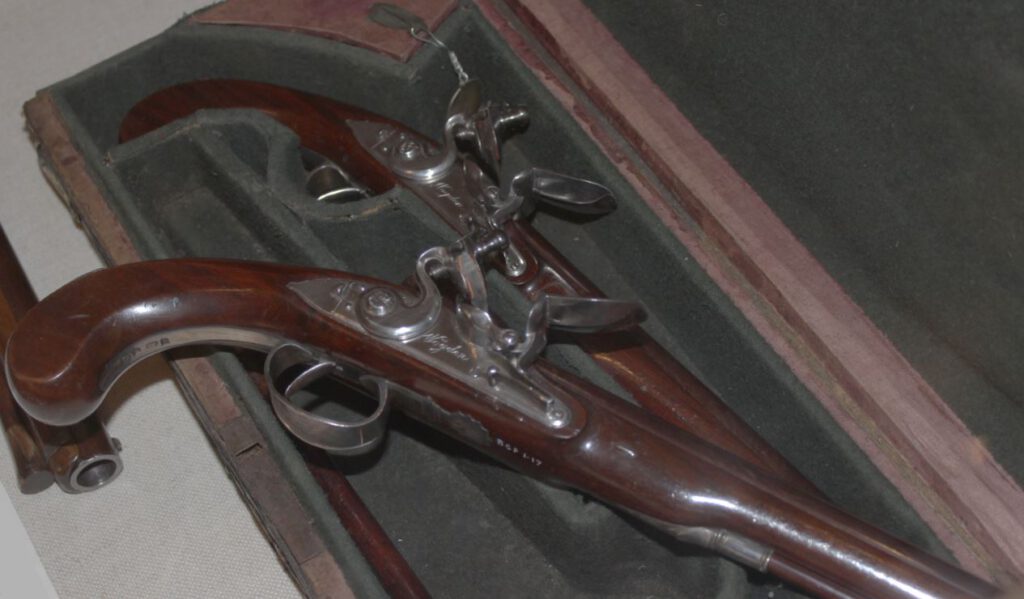
Existing Rules for Duelling
If the Irish Code Duello of 1777 did not exist (prior to 1827), which rules guided the handling of a duel?
I have compiled some rule for you that are mentioned in the above books. Please note that they are a personal selection. They do not form a duelling code.
Advice for Seconds (from “General rules and instructions for all seconds in duels, by a late captain in the army”, 1793)
- Whenever a gentleman has the misfortune to be solicited, in friendship, to take upon himself this serious office (acting as a Second) he ought gravely to consider on the application, inform himself, most minutely, of very particular in dispute, and duly to reflect the nature of it´.
- (A Second) is to try, and even rack is invention for any new and reasonable light that can be thrown upon it, in order to reconcile the party aggrieved.
- The suffering men to fight in a state of drunkenness is no less preposterous than shocking to the mind; because no man’s courage is the better established by any thing he does in such moments.
- When swords are chosen for the duel (there are) three material things the Seconds have to look to. The first is that the swords be of equal length; the second, that the sod they stand upon be clean, dry, and even; and lastly, above all, that the combatants be placed as far asunder as that they must advance to each other before they can come to the assault.
- (For duels with pistols) the ground should be taken in an open situation, and crossways of the ridges, if there are any. By due observance of this, much unnecessary would be avoided, and more be left within the Power of Chance.
- (Pistols are to be) loaded (by the Seconds) in the present of each other.
- Ten yards is the nearest distance the parties should be suffered to fight at.
- In settling of trivial disputes (which are by far the greatest number) twelve, or more yards, might well be given, according to the nature of the affair.
- (…) the Seconds ought always to place a good and sufficient mark, and give the positive order for no advance beyond it, when they come to fire.
- (…) we can but have the choice of these two ways (to regulate the firing), by word or signal (…) a preference should always be given to that by signal.
- (Seconds) never should deliver a pistol cocked, nor ever a fresh one without using the utmost endeavours to reconcile the parties, for though wrath and revenge may actuate the Principals, yet surely the Seconds should feel nothing but humanity.
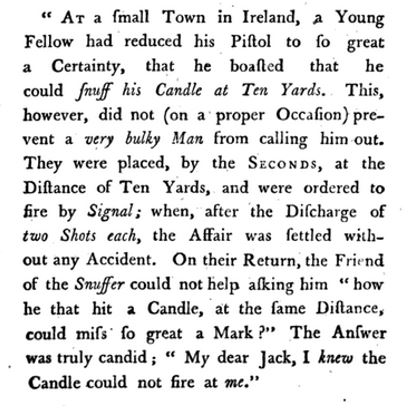
Rules found in “The Principles of Duelling; by Samuel Stanton (Lieut. 37th Regiment), 1790
- A Gentleman (is) not to meet any one but a Gentleman
- Making apologies (is), in certain cases, no disgrace
- In disputes or altercations, no improper language or behaviour (is) to be made use of.
- Gentlemen (are) not to be tanecessited to receive challenges on improper occasions
- Gentlemen (are) to be prevented fighting when intoxicated.
- In all cases whatever, the party who gave the affront, (is) to receive the first fire.
The Royal Code of Duelling
The “Royal Code” is the first authentic code of the long 18th century I could find. It first appeared in Joseph Hamilton’s work “The only approved guide through all the stages of a quarrel: containing the royal code of honor; reflections upon duelling; and the outline of a court for the adjustment of dispute”, published in 1829. It comprises 60 rules.
I give you a taste of them in the picture below, and provide the link to read them online here (p. 1 – p. 23) https://archive.org/details/onlyapprovedguid00hami
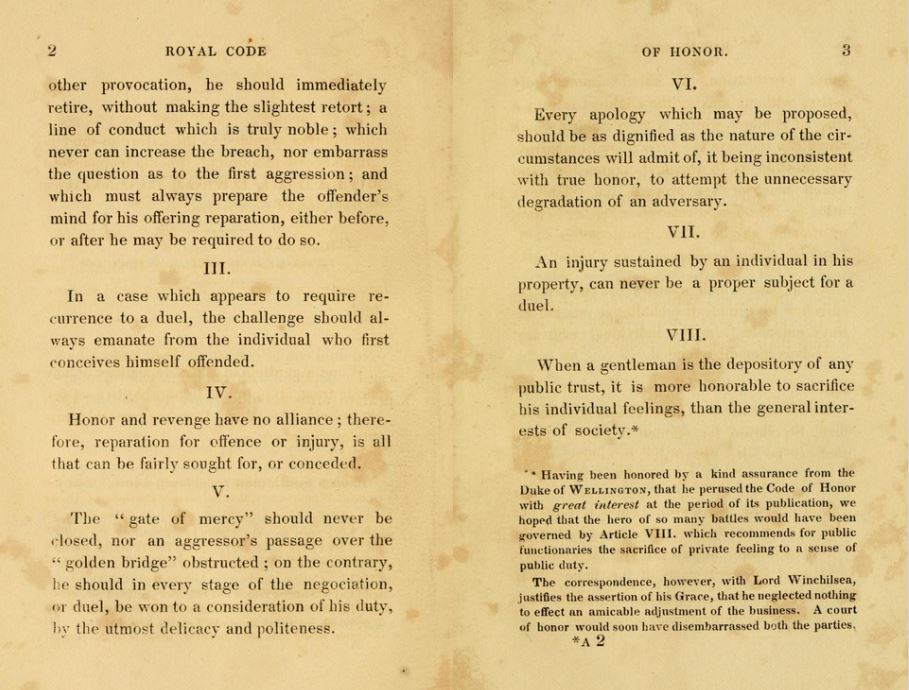
Sources
- Dianne L. Durante, Duelling Codes, Part 1 / Duelling Codes, Part 2, at https://diannedurantewriter.com/archives/1646 / https://diannedurantewriter.com/archives/1696
- Personal Sketches of His Own Times, volume 2, by Sir Jonah Barrington, 1827: https://books.google.com.mm/books?id=p2g9AAAAIAAJ&printsec=frontcover#v=onepage&q&f=false
- Duhaime’s Law Dictionary: http://www.duhaime.org/LegalDictionary/C/CodeDuello.aspx
- TheFreeDictionary.com by Farlex: https://legal-dictionary.thefreedictionary.com/Dueling
Case Western Reserve Law Review, Volume 51|Issue 12000, “The Attorney as Duelist’s Friend: Lessons from the Code Duello” by Douglas H. Yarn - “The principles of duelling; with rules to be observed in every particular respecting it”, by Samuel Stanton (Lieut. 37th Regiment), Published in 1790 https://books.google.de/books?id=zOgMtAEACAAJ&pg=PP15&hl=de&source=gbs_selected_pages&cad=2#v=onepage&q&f=false
- “A full inquiry Into the subject of suicide: to which are added (as being closely connected with the subject) two treatises on duelling and gaming in two volumes”, by Charles Moore, published in 1790 https://books.google.de/books?id=f24PAAAAIAAJ&printsec=frontcover&dq=inauthor:%22Charles+Moore%22&hl=de&sa=X&ved=2ahUKEwii26TZ8MXrAhWwl4sKHZkNCqkQ6AEwAnoECAMQAg#v=onepage&q&f=false
- “General rules and instructions for all seconds in duels, by a late captain in the army”, published in 1793 https://books.google.co.uk/books?id=QrxYAAAAcAAJ&pg=PR3&lpg=PR3&dq=Advice+to+seconds:+general+rules+and+instructions+for+all+seconds+in+duels.+By+a+late+captain+in+the+army&source=bl&ots=6-NYHmE8yV&sig=0zzKmxgTcCtO6ac_hklEYUaSr_E&hl=en&sa=X&ved=0ahUKEwizqM7stIzYAhWPUlAKHY0HBhAQ6AEIPjAE#v=onepage&q&f=false
- “The Young Man of Honour’s Vade-mecum: Being a Salutory Treatise on Duelling, Together with the Annals of Chivalry, the Ordeal Trial, and Judicial Combat, from the Earliest Times”, by Abraham Bosquett, published in 1817 https://books.google.de/books?id=2kdfAAAAcAAJ&pg=PA61&lpg=PA61&dq=The+Young+Man+of+Honour%27s+Vade+Mecum++%E2%80%93+A+Treatise+on+Duelling&source=bl&ots=mTS3USJMdR&sig=ACfU3U1VUUwKfA5LRxfg98LqUbcR0pa-Ng&hl=de&sa=X&ved=2ahUKEwiL3I-Zn8HrAhWHN8AKHVFJDFE4ChDoATACegQIBRAB#v=onepage&q&f=false
- “Some Short and Useful Reflections Upon Duelling: Which Should be in the Hands of Every Person who is Liable to Receive a Challenge, Or an Offence” by Hamilton Joseph, published in 1823 https://books.google.de/books?id=MlwPAAAAIAAJ&printsec=frontcover&dq=Some+Short+and+Useful+Reflections+Upon+Duelling:+Which+Should+be+in+the+Hands+of+Every+Person+who+is+Liable+to+Receive+a+Challenge,+Or+an+Offence+Hamilton+Joseph&hl=de&sa=X&ved=2ahUKEwi2-e-kn9TrAhVJecAKHX5-DS4QuwUwAHoECAAQCA#v=onepage&q&f=false
- “The only approved guide through all the stages of a quarrel: containing the royal code of honor; reflections upon duelling; and the outline of a court for the adjustment of disputes” by Hamilton, Joseph, published in 1829 https://archive.org/details/onlyapprovedguid00hami
- “Code of honour” by John Lyde Wilson, published in 1838 https://archive.org/details/codeofhonororrul00wils/page/n1/mode/2up
Related articles
Article by Anna M. Thane, author of the novel
“Von tadellosem Ruf” (http://amzn.to/2TXvrez)
